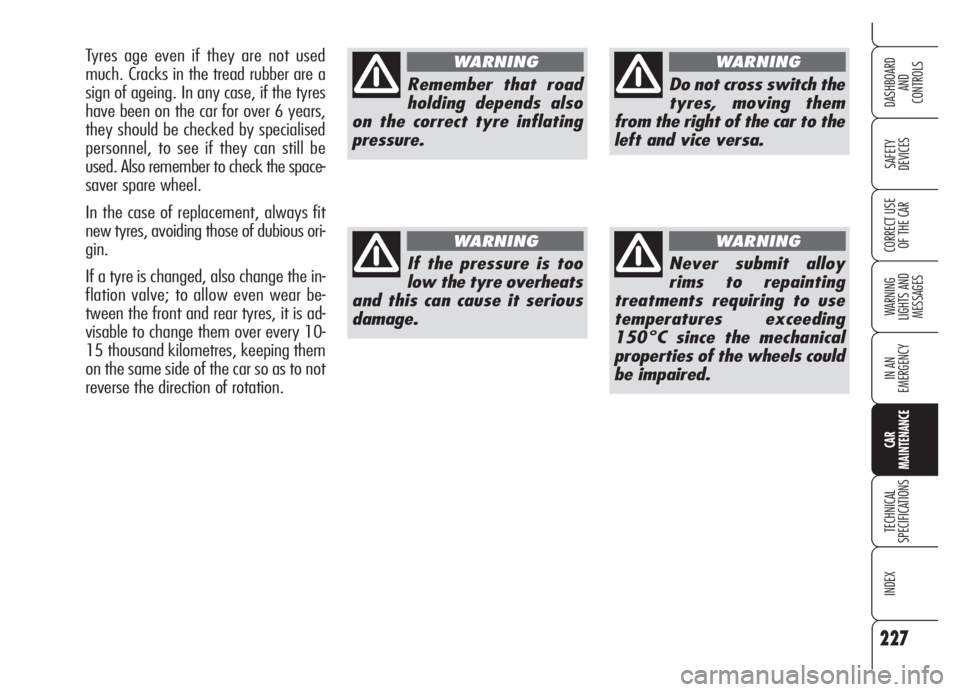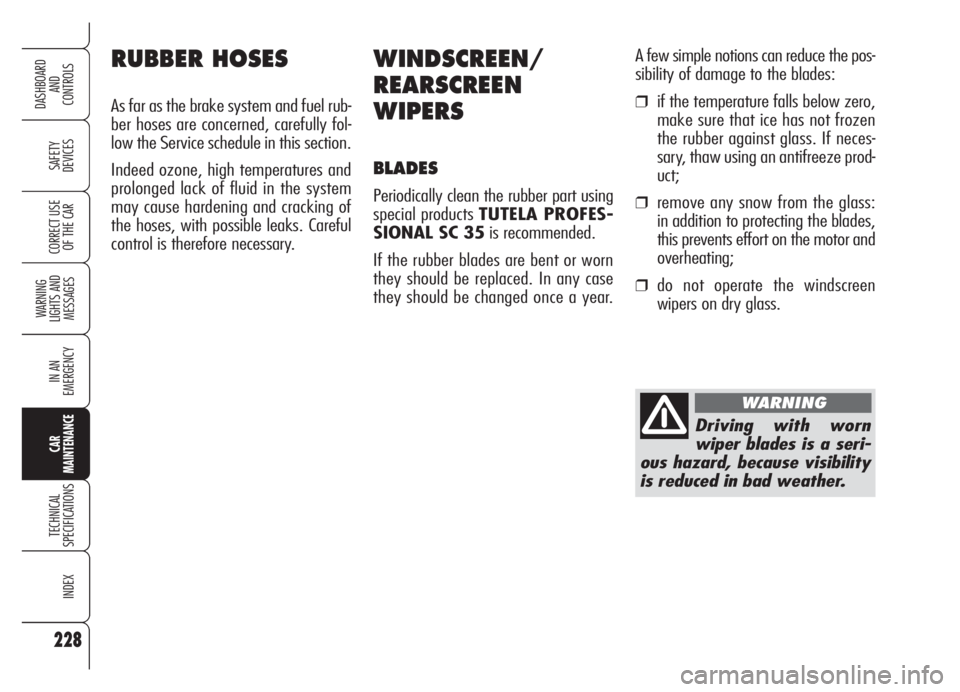2008 Alfa Romeo Brera/Spider warning
[x] Cancel search: warningPage 228 of 270

227
SAFETY
DEVICES
WARNING
LIGHTS AND
MESSAGES
IN AN
EMERGENCY
CAR
MAINTENANCE
TECHNICAL
SPECIFICATIONS
INDEX
DASHBOARD
AND
CONTROLS
CORRECT USE
OF THE CAR
Remember that road
holding depends also
on the correct tyre inflating
pressure.
WARNING
If the pressure is too
low the tyre overheats
and this can cause it serious
damage.
WARNING
Never submit alloy
rims to repainting
treatments requiring to use
temperatures exceeding
150°C since the mechanical
properties of the wheels could
be impaired.
WARNING
Do not cross switch the
tyres, moving them
from the right of the car to the
left and vice versa.
WARNINGTyres age even if they are not used
much. Cracks in the tread rubber are a
sign of ageing. In any case, if the tyres
have been on the car for over 6 years,
they should be checked by specialised
personnel, to see if they can still be
used. Also remember to check the space-
saver spare wheel.
In the case of replacement, always fit
new tyres, avoiding those of dubious ori-
gin.
If a tyre is changed, also change the in-
flation valve; to allow even wear be-
tween the front and rear tyres, it is ad-
visable to change them over every 10-
15 thousand kilometres, keeping them
on the same side of the car so as to not
reverse the direction of rotation.
Page 229 of 270

228
SAFETY
DEVICES
WARNING
LIGHTS AND
MESSAGES
IN AN
EMERGENCY
CAR
MAINTENANCE
TECHNICAL
SPECIFICATIONS
INDEX
DASHBOARD
AND
CONTROLS
CORRECT USE
OF THE CAR
WINDSCREEN/
REARSCREEN
WIPERS
BLADES
Periodically clean the rubber part using
special products TUTELA PROFES-
SIONAL SC 35is recommended.
If the rubber blades are bent or worn
they should be replaced. In any case
they should be changed once a year.
RUBBER HOSES
As far as the brake system and fuel rub-
ber hoses are concerned, carefully fol-
low the Service schedule in this section.
Indeed ozone, high temperatures and
prolonged lack of fluid in the system
may cause hardening and cracking of
the hoses, with possible leaks. Careful
control is therefore necessary.
Driving with worn
wiper blades is a seri-
ous hazard, because visibility
is reduced in bad weather.
WARNING
A few simple notions can reduce the pos-
sibility of damage to the blades:
❒if the temperature falls below zero,
make sure that ice has not frozen
the rubber against glass. If neces-
sary, thaw using an antifreeze prod-
uct;
❒remove any snow from the glass:
in addition to protecting the blades,
this prevents effort on the motor and
overheating;
❒do not operate the windscreen
wipers on dry glass.
Page 230 of 270

229
SAFETY
DEVICES
WARNING
LIGHTS AND
MESSAGES
IN AN
EMERGENCY
CAR
MAINTENANCE
TECHNICAL
SPECIFICATIONS
INDEX
DASHBOARD
AND
CONTROLS
CORRECT USE
OF THE CARChanging the rearscreen
wiper blades
Proceed as follows:
❒raise cover A-fig. 15and remove
the arm by loosening the nut Bthat
secures it to the revolving pin;
❒fit the new arm, tighten the nut B
and then lower the cover A.
SPRAY NOZZLES
If the jet of fluid is missing, firstly check
that there is fluid in the reservoir: see
“Checking fluid levels” in this section).
Then check that the nozzle holes are not
clogged, if necessary use a needle.
Fluid jets shall be directed at about 1/3
height from the window upper edge.
HEADLIGHT WASHERS
Regularly check that the spray jets are
intact and clean.
The headlight washers are automatical-
ly switched on when the windscreen
washer is operated and the dipped
beams are on. Changing the windscreen
wiper blades fig. 14
How to remove the blade:
– raise the windscreen wiper arm A;
– turn the blade Bby 90° around pin
C, on the final section of the arm;
– remove the blade from the pin C.
How to refit the new blade:
– fit pin Cinto the hole in the middle
of the blade B;
– refit the arm with the blade on the
windscreen.
A0F0080mfig. 14A0F0249mfig. 15
Page 231 of 270

230
SAFETY
DEVICES
WARNING
LIGHTS AND
MESSAGES
IN AN
EMERGENCY
CAR
MAINTENANCE
TECHNICAL
SPECIFICATIONS
INDEX
DASHBOARD
AND
CONTROLS
CORRECT USE
OF THE CAR
These include:
❒Painting products and systems which
give the car particular resistance to
corrosion and abrasion;
❒Use of galvanised (or pretreated)
steel sheets, with high resistance to
corrosion;
❒Spraying of plastic parts, with a pro-
tective function, in the more exposed
points: underdoor, inner fender parts,
edges, etc;
❒Use of “open” boxed sections to pre-
vent condensation and pockets of
moisture from triggering rust inside;
❒Use of special anti-abrasion protec-
tive tapes in the most exposed areas
(e.g.: rear mudguard, etc.).
BODY AND UNDERBODY
WARRANTY
Your car is covered by warranty against
perforation due to rust of any original el-
ement of the structure or body. For the
general terms of this warranty, refer to
the Alfa Romeo Warranty booklet.
BODYWORK
PROTECTION FROM
ATMOSPHERIC AGENTS
The main causes of corrosion are the fol-
lowing:
❒atmospheric pollution;
❒salty air and humidity (coastal areas,
or hot humid climates);
❒seasonal environment conditions.
Not to be underestimated is also the
abrasive action of wind-borne atmos-
pheric dust and sand and mud and grav-
el raised by other cars.
On your car, Alfa Romeo implemented
the best manufacturing technologies to
effectively protect the bodywork against
corrosion.
Page 232 of 270

231
SAFETY
DEVICES
WARNING
LIGHTS AND
MESSAGES
IN AN
EMERGENCY
CAR
MAINTENANCE
TECHNICAL
SPECIFICATIONS
INDEX
DASHBOARD
AND
CONTROLS
CORRECT USE
OF THE CAR
To wash the car correctly proceed as fol-
lows:
❒remove the aerial from the roof to
prevent damage to it if the car is
washed in an automatic system;
❒wash the body using a low pressure
jet of water;
❒wipe a sponge with a slightly soapy
solution over the bodywork, fre-
quently rinsing with the sponge;
❒rinse well with water and dry with
a jet of air or a chamois leather.
When drying, take particular care with
the less visible parts like door surrounds,
bonnet and around the headlights where
water may stagnate. The car should not
be taken to a closed area immediately,
but left in the open so that residual wa-
ter can evaporate.
Do not wash the car after it has been left
in the sun or with the bonnet hot: this
may alter the shine of the paintwork.
ADVICE FOR PRESERVING
THE BODYWORK
Paint
Paintwork does not only serve an aes-
thetic purpose, but also protects the un-
derlying sheet metal.
In the case of deep scrapes or scores,
you are advised to have the necessary
touching up carried out immediately to
avoid the formation of rust. Use only
original paint products for touching up
(see “Bodywork paint identification
plate” in section “Technical specifica-
tion”).
Normal paint maintenance consists in
washing at intervals depending on the
conditions and environment of use. For
example, in highly polluted areas, or if
the roads are sprayed with salt, it is wise
to wash the car more frequently.
Detergents cause water
pollution. Therefore the
car should be washed
in areas equipped for collecting
and purifying the liquid used in
the washing process.
Exterior plastic parts must be cleaned in
the same way as the rest of the car.
Where possible, do not park under trees;
the resinous substance many species re-
lease give the paint a dull appearance
and increase the possibility of triggering
rust processes.
IMPORTANTBird droppings must be
washed off immediately and thorough-
ly as the acid they contain is particular-
ly aggressive.
Page 233 of 270

232
SAFETY
DEVICES
WARNING
LIGHTS AND
MESSAGES
IN AN
EMERGENCY
CAR
MAINTENANCE
TECHNICAL
SPECIFICATIONS
INDEX
DASHBOARD
AND
CONTROLS
CORRECT USE
OF THE CAR
Engine compartment
At the end of the winter the engine com-
partment should be carefully washed,
without directing the jet against electronic
control units. Contact a specialised work-
shop to have this done.
IMPORTANTThe car should be
washed with the engine cold and the key
removed from the ignition device. After
washing make sure that the various pro-
tections (e.g. rubber caps and various cov-
ers) have not been damaged or removed. Front headlights
Front headlights shall be washed with
soft cloth moistened with water and car
detergent.
IMPORTANT Cleaning headlight lens-
es with a dry cloth will damage the
headlights with lack of performance as
a consequence. Solvents mat the lens-
es with lack of performance as a con-
sequence.
IMPORTANTWhen washing front
headlights using a water nozzle, keep
the water jet at 2 cm at least from lens-
es. Windows
Use specific window cleaner products.
Use also clean cloths to avoid scratching
the glass or damaging the transparen-
cy.
IMPORTANTThe inside of the
rearscreen should be wiped gently with
a cloth in the direction of the filaments
to avoid damaging the heating device.
Page 234 of 270

CLEANING LEATHER SEATS
(optional for versions/
markets where applicable)
Remove dried on dirt with lightly moist-
ened chamois leather or cloth without
pressing too hard.
Remove liquid or grease stains with a dry
absorbent cloth without rubbing. Then
wipe with a soft cloth or chamois leather
with water and neutral soap.
If the stain persists, use specific prod-
ucts, carefully following the instructions
for use.
IMPORTANTNever use spirit or al-
cohol-based products.
233
SAFETY
DEVICES
WARNING
LIGHTS AND
MESSAGES
IN AN
EMERGENCY
CAR
MAINTENANCE
TECHNICAL
SPECIFICATIONS
INDEX
DASHBOARD
AND
CONTROLS
CORRECT USE
OF THE CAR
Upholstery of your car
has been designed to
withstand wear deriv-
ing from common use of the car.
You are however recommended
to avoid strong and/or contin-
uous scratching with clothing ac-
cessories such as metallic buck-
les, studs, Velcro fastenings and
the like, since these items cause
circumscribed stress of the cov-
er fabric that could lead to yarn
breaking, and damage the cov-
er as a consequence.INTERIORS
Periodically check that water is not
trapped under the mats (due to water
dripping off shoes, umbrellas, etc.)
which could cause oxidisation of the
sheet metal.
CLEANING SEATS AND
FABRIC AND VELVET PARTS
Use a soft brush or vacuum cleaner to
remove dust. Velvet is cleaned better if
the brush is moistened.
Rub the seats with a sponge moistened
with a solution of water and neutral de-
tergent.
Page 235 of 270

234
SAFETY
DEVICES
WARNING
LIGHTS AND
MESSAGES
IN AN
EMERGENCY
CAR
MAINTENANCE
TECHNICAL
SPECIFICATIONS
INDEX
DASHBOARD
AND
CONTROLS
CORRECT USE
OF THE CAR
INTERIOR PLASTIC PARTS
Clean plastic parts with a cloth
mositened with water and non-abrasive
neutral detergent. To remove grease or
hard stains, use appropriate products de-
signed to preserve the appearance of
components.
IMPORTANTNever use spirit or pe-
troleum to clean the instrument panel
or other plastic parts.Never use flammable
products like oil ether
or rectified petrol for cleaning
car interiors. Electrostatic dis-
charges generated by rubbing
during cleaning operations
could cause fire.
WARNING
Do not keep aerosol
cans in the car: they
might explode. Aerosol cans
must never be exposed to a
temperature above 50°C. The
temperature inside the car ex-
posed to the sun may go well
beyond that figure.
WARNING
STEERING WHEEL/GEAR
LEVER KNOB WITH
GENUINE LEATHER
COVERING
(optional for versions/
markets where applicable)
These components shall only be cleaned
with water and neutral soap. Never use
spirit or alcohol-based products.
Before using special products for clean-
ing interiors, read carefully label in-
structions and indications to make sure
they are free from spirit and/or alcohol-
based substances.
If when cleaning the windscreen with
special glass products, some drops fall
on the leather covering of the steering
wheel/gear lever knob remove them
immediately and then clean with wa-
ter and neutral soap.
IMPORTANTTake the utmost care
when engaging the steering lock to pre-
vent scratching the leather covering.